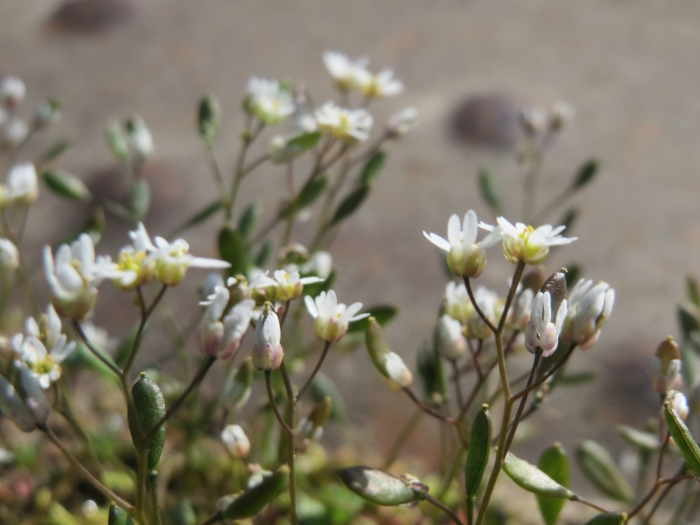Common Whitlowgrass
(Draba verna)
Common Whitlowgrass (Draba verna)
/
/

Andreas Rockstein
CC BY-SA 4.0
Image By:
Andreas Rockstein
Recorded By:
Copyright:
CC BY-SA 4.0
Copyright Notice:
Photo by: Andreas Rockstein | License Type: CC BY-SA 4.0 | License URL: http://creativecommons.org/licenses/by-sa/4.0/ | Rights Holder: Andreas Rockstein | Publisher: iNaturalist | Date Created: 2017-03-25T15:58:04-07:00 |























Estimated Native Range
Summary
Draba verna, commonly known as common whitlowgrass, is a small spring-flowering annual herb native to a variety of habitats including rocky outcrops, walls, pavements, and bare ground across Europe, western Asia, and parts of North Africa. It typically grows to a height of 2-5 inches (5-13 cm), and while it may seem inconspicuous, it is easily identified by its small white flowers that appear in early spring. The plant forms a basal rosette of leaves from which emerge one or more flowering stems, each topped with a cluster of tiny flowers.
Common whitlowgrass is valued for its early bloom time, providing nectar and pollen for early-season pollinators. It is often found in disturbed sites, which makes it a useful plant for colonizing bare or poor soils, and it can be used in rock gardens or alpine collections. In cultivation, it requires minimal care, thriving in full sun to partial shade and preferring well-drained soils. However, due to its potential for invasiveness, it should be planted with caution and monitored to prevent unwanted spread.CC BY-SA 4.0
Common whitlowgrass is valued for its early bloom time, providing nectar and pollen for early-season pollinators. It is often found in disturbed sites, which makes it a useful plant for colonizing bare or poor soils, and it can be used in rock gardens or alpine collections. In cultivation, it requires minimal care, thriving in full sun to partial shade and preferring well-drained soils. However, due to its potential for invasiveness, it should be planted with caution and monitored to prevent unwanted spread.CC BY-SA 4.0
Plant Description
- Plant Type: Herb
- Height: 0.1-0.5 feet
- Width: 0.1-0.5 feet
- Growth Rate: Rapid
- Flower Color: White
- Flowering Season: Spring
- Leaf Retention:
Growth Requirements
- Sun: Full Sun, Part Shade
- Water: Medium
- Drainage: Medium, Fast
Common Uses
Drought Tolerant, Groundcover, Low Maintenance
Natural Habitat
Rocky outcrops, walls, pavements, and bare ground across Europe, western Asia, and parts of North Africa
Other Names
Common Names: Whitlow Grass, Spring Whitlowgrass, Common Draba, Common Whitlowgrass, Shadflower
Scientific Names: , Draba verna, Draba ambigens, Draba boerhaavii, Draba boerhavii, Draba boerhavii, Draba gilgiana, Draba glabrescens, Draba inflata, Draba krockeri
GBIF Accepted Name: